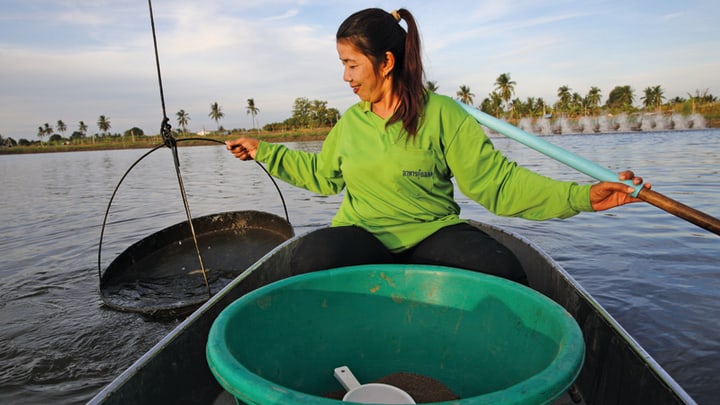
Across the world, developed and developing countries alike are advancing their commitments toward the United Nations Sustainable Development Goals. From health, education, and women’s empowerment to no poverty, life on land, life below water, and sustainable consumption, the ambitious agenda of the SDGs is creating opportunities for all countries and all people.
But there is one action within the SDG framework that has been underestimated: That action is trade.
Trade keeps goods, services, and capital flowing. Whether it be ending hunger and poverty, providing decent work and economic growth, industry, innovation and infrastructure, and sustainable cities and communities, trade is a common thread woven throughout the goals’ targets — not just in SDG 17 where it is mentioned briefly. That’s because trade can be counted on to do a number of things:
1. Encourage cooperation.
By its very nature, successful trade requires its participants to reach across sectors, regions, and boundaries, and to engage in the kind of collaborative, multistakeholder partnerships that are encouraged under SDG 17.
2. Circulate knowledge.
Trade does more than move goods. It also serves as a conduit through which we can distribute, share, and exchange knowledge, ideas, innovations, and technologies that have the power to transform lives in underdeveloped regions. It can then be mobilized by partnerships generated through trade and that knowledge acquisition has the potential to fuel progress across a broad range of SDGs.
3. Provide access to new opportunities.
Trade furnishes people across the world with critical connections to markets, better technologies, financing, and investment — and provides them with the tools to increase incomes, improve quality of life, boost purchasing power, and gain the food security and zero hunger sought under SDG 2, which looks to end hunger in all its forms by 2030 and to achieve food security.
4. Generate shared benefits.
Trade benefits are bidirectional because sellers and buyers have a mutual incentive to exchange goods and services. Both parties acquire access to markets that otherwise would not be available. People in developing regions, for example, can generate new income for purchase of consumer goods. Those in developed nations may benefit from greater selection and availability of goods for consumers — and the opportunity to sell into growing markets. When channels are open, both parties come out ahead.
As such, trade — whether local, regional, or international — plays an indispensable role in improving livelihoods in every part of the world and should be among the factors considered when designing sustainable development solutions.
Trade as an enabler for SDG success
Through my role as a board member for Cultivating New Frontiers in Agriculture — a nonprofit that creates and implements agricultural development programs — I have witnessed the ways in which private sector initiatives — underpinned by trade — can help smallholder farmers gain access to markets, investment, opportunities, and to food security and improved livelihoods.
CNFA has developed a model for private sector farm service centers, which provide farm resources and services to underdeveloped rural communities where smallholder farmers lack the technology, resources, and expertise to increase production, reach markets, and assure economic and food security.
“Trade — whether local, regional, or international — plays an indispensable role in improving livelihoods in every part of the world and should be among the factors considered when designing sustainable development solutions.”
— Devry Boughner Vorwerk, corporate vice president of corporate affairs, CargillIn addition to providing fertilizers, seeds, and veterinary services, these small and medium-sized businesses also offer farmers access to training and information, financing, credit, and assistance in marketing their output.
Another example is the Mexican Foundation for Rural Development, which partnered with Cargill to support Yucatan’s smallholder farmers with training in agronomic best practices and technology use. Agronomists, educators, and field managers worked with farmers over a five-year period and visited farm communities at 15-day intervals to provide real time advice. The initiative produced dramatic increases in yields and income, and farmers used their new business skills to organize, increase access to local and regional markets, negotiate better prices for their crops, and reduce costs. The farmers are now self-sufficient and have modest reserves for health care, education, and other necessities.
As these examples illustrate, the benefits of sustainable development solutions supported by trade have the potential to lift people — especially those in agricultural societies — out of poverty, hunger, and mere subsistence. The examples also embody why solutions supported by trade are at the core of a company like Cargill.
While the company operates in 70 countries, and supplies food and agricultural, financial, and industrial products to customers across the globe, Cargill at the most basic level is in the business of ensuring that people around the world have access to a dependable, affordable, and nutritious supply of food.
Together, the development community needs to leverage the connections created by trade to help us achieve our targets across all of the SDGs. Trade builds peaceful and constructive relations among governments and people. When we understand and advocate for the role of trade in our sustainable development efforts, we enhance our ability to spread prosperity and peace to communities around the world.
Devex World is on June 12, 2018 at the Mead Center for the American Theater in Washington, D.C., and Cargill is one of the event’s innovation partners. Find out more about the event here.




